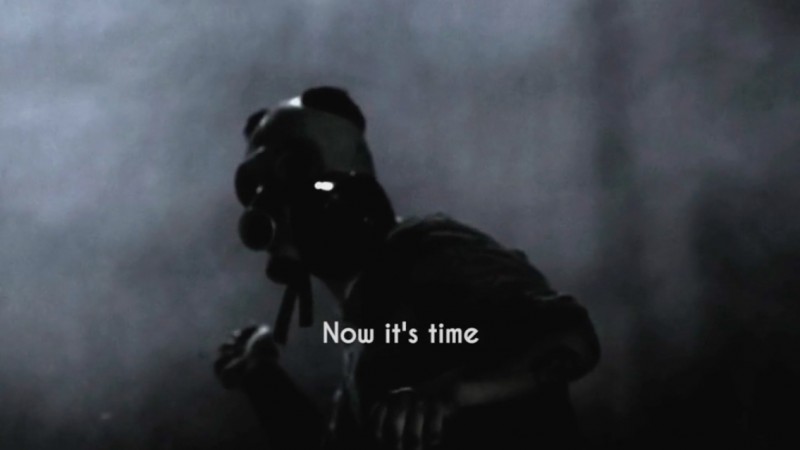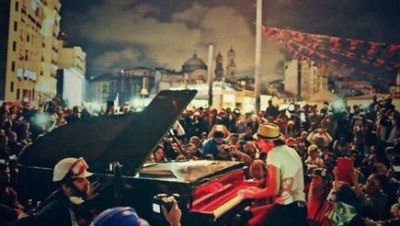
Screenshot from video shown at the meeting and shared by MODE Istanbul
As noted in a recent Global Voices article, the Gezi protests in Turkey were born in large part out of a desire to reclaim the public sphere, and lay the foundations of a culture of progress through participation. Gezi remains a powerful symbol for people in Turkey who want to have a say in what goes on in their neighbourhood and urban environment.
However, calls for mass participation and collective action in Turkey did not begin with Gezi, and they certainly have not ended with it.
On December 13, like-minded people gathered at the Radical Democracy Urban Encounter, organized by MODE Istanbul, a creative collective. The RDUE is a space for sharing experiences and creating visual products that highlight efforts to make cities work on behalf of the many, rather than the few.

Piano recital during Gezi protests. Shared by takethesquare.
The event took place as part of Which Human Rights? Film Festival, and the main purpose was to discuss different ways of reclaiming public spaces. Within this scope, seven different people from different backgrounds shared their stories and their ideas.
Some of the civic organisations represented at the workshop defined themselves as Children of Gezi, while others have been active for years.
Below are three of the seven public space experiences highlighted at the forum.
A garden for all
One of the best examples of the battle for public spaces in Turkey is the struggle over Istanbul's Kuzguncuk garden, ongoing since 1992.
Kuzguncuk garden has been a public space for 700 years, and a crucial component of its eponymous neighbourhood, where residents grow vegetables and use the area to sit and relax.
However, for more than two decades there have been persistent attempts to convert Kuzguncuk garden into a zone for housing or other purposes. Last year, Kuzguncuk residents opposed alleged plans to construct a private school on the garden's territory.
Bogachan Dundaralp, an award winning architect who spoke at the Radical Democracy Urban Encounter, is actively involved in defending the garden, a process he has tracked on his personal blog.
Amid threats to the garden, Dundaralp served as a bridge between residents and the government, lobbying for the garden to be safeguarded. Thanks to combined efforts the garden seems safe as a public space for now.
Bostan kurtulduysa sebebi bence onleyici eylem & somut alternatif cozum onerisi. Budur! Sirf protestoyla fark yaratilmaz. #kentkarsilasmasi
— Mertalt (@mertalt) December 13, 2014
If the garden is saved, it is thanks to preventive actions & concrete alternative solution proposals. This is it! You can not make a difference only with protests. #urbanmeeting
Taking back the streets
Arzu Erturan is another influencer. She is president of Sokak Bizim association (The Street is Ours). Her main aim is to ensure livable streets that can belong to people. Sokaklar Bizim creates different events in different parts of Istanbul, helping residents identify the obstacles that can prevent residents from enjoying the city's urban landscape. Now passersby regularly find signs reading “where is the pavement?” posted by Erturan's group on cramped thoroughfares, along with other notices calling for more public ownership of the ground beneath residents’ feet.
#kaldırımnerede pic.twitter.com/QzbEopUleE
— Emre Agatay (@EmreAgatay) December 12, 2013
#whereisthepavement
Preserving Istanbul's ecological integrity
Other organisations such as Kuzey Ormanları Savunması (Northern Forests Defense) face struggles without an end in sight. Their cause is the protection of the ecological integrity of the last forests, water basins, cultivated areas, parks, endemic plants, and animals of Istanbul, located in the city's northern part.
Specific projects the group oppose include the third bridge, the new airport, and many roads currently being built in the north. Kuzey Ormanları Savunması taps into the power of residents living close to these projects, and represents their claims.
The situation in the city's north is well summarised by this tweet:
Anlatılan çocuklarının hikayesidir. Kuzey Ormanları Uyarıyor “beni yok ettiniz” http://t.co/WL1qOCizKK #kuzeyormanları #ağlasevgiliyurdum
— Selahaddin Yildirim (@csselo) December 12, 2014
This is your children's story.
Northern Forests warn: “You wiped me out”
#northernforests
#crymybelovedcountry
Civic action against the construction-heavy approach to urban development afflicting Turkey's largest city takes many forms. In addition to the direct campaigning of many of the groups present at RDUE, there are also citizen media portals like 140journos, alternative mapping projects, art collectives, and efforts to document urban life from different perspectives as gentrification proceeds apace.
Each of these efforts has a major role to play in terms of reclaiming and redefining public spaces.
The first RDUE is likely to be followed by many others, as momentum grows towards creating a greener, more social, more democratic existence in Turkey's largest city.







4 comments